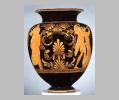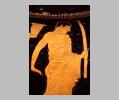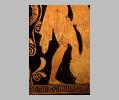| Collection: | University Museums, University of Mississippi |
| Summary: | Side A: komos. Side B: komos. |
| Ware: | Attic Red Figure |
| Painter: | Attributed to Polygnotos |
| Context: | From Vulci |
| Date: | ca. 450 BC - ca. 440 BC |
| Dimensions: | H 0. 43 m.; D 0.34 m. |
| Primary Citation: | |
| Shape: | Stamnos |
| Beazley Number: | 213397 |
| Region: | Etruria |
| Period: | Classical |
Condition:
Excellent condition; ancient repair of one handle with iron rivets. Slight surface wear.
Decoration Description:
Around the outside of the handles is an egg-and-dart pattern. Above and below at the sides of the handles are addorsed palmettes and spirals. Bordering the scene at the bottom is a cross and meander pattern, and at the top (near the neck) is a tongue pattern. The rim has an egg-and-dart pattern on it, as well. Robinson compared the shape of the vessel, and the decoration around the handles, to a signed stamnos by Polygnotos
Side A: On the left is a tall bearded man, in profile to the right. He wears a fillet and a himation, and walks forward, supported by a flute girl. Near him is the inscription
Side B: Three draped youths stand together. The one on the left faces to the right, holding a skyphos in his left hand. His other hand is hidden under his himation. The middle youth, with himation wrapped around his waist and draped over his left arm, also faces right. He gestures with his right hand, and carries a torch of twigs in his left. Facing him on the right is the third youth, who looks back at him as he walks to the right. He raises his right hand to the center figure.
Inscriptions:
Robinson: traces of signature (19). Side A, near the appropriate figures:
Collection History:
Gift of Helen Tudor Robinson, 1959. Formerly in the D.M. Robinson collection, Harvard inv. 204.
Sources Used:
Mississippi museum archives. AJA 60 (1956) 19-20, pl. 15-16





